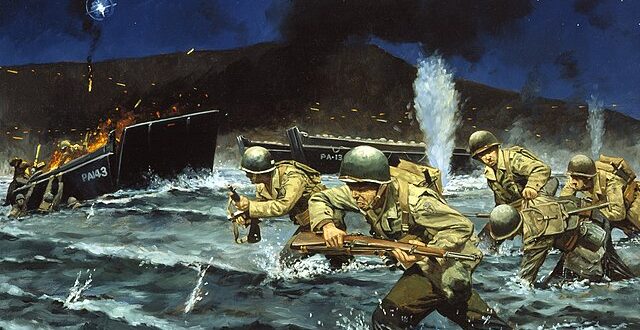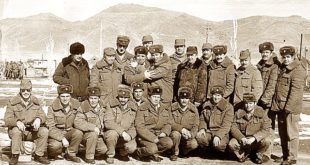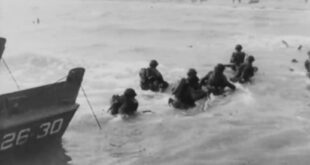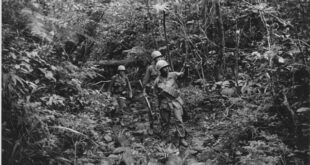“Tell people what we did in World War II,” one soldier said. “Tell them about Salerno.”
by Susan Katz Keating
EAGLE PASS, TX – In a parking lot near the U.S. southern border, members of the Texas National Guard encountered our team from Soldier of Fortune. The “T-Patchers” just had come in from duty on Operation Lone Star, the state border security mission, when they spotted our SoF ballcaps. They waved hello, and asked us to write about them – but in a way that won’t get them busted for talking to the press.
“Write about our legacy. Tell people what we did in World War II,” one soldier said. “Tell them about Salerno.”
The border is a right-now issue that we plan to keep covering, particularly in terms of cartel activity inside the United States. Meanwhile, we are happy to comply with the T-Patchers’ request that we write about the legacy they inherited from their predecessors at war in Salerno. I’ve written about it previously, and draw here on some interviews from an earlier day. The story begins in the lead-up to the Allied invasion of Italy.
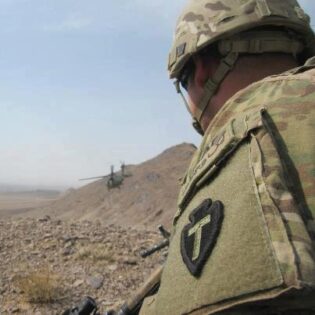
Today’s Texas T-Patchers have a long and rich legacy.
World War II: The T-Patchers Head to War
By August 1943, after more than two years of intense combat in World War II, the Allies formed a plan to use Italy as a means to secure Western Europe. As part of that effort, the Texas T-Patchers of the 36th Infantry Division took part in Operation Avalanche, a massive amphibious assault at Salerno.
“They were among the first American soldiers to set foot in Europe,” said author Dave Gutierrez, whose cousin, Pfc. Ramon Gutierrez, was among them. “They were assigned to be the tip of the spear.”
They just didn’t know it.
READ MORE: Texas Recaptures Island From Cartel Smugglers
In September 1943, these federalized National Guard “T-Patchers” learned that they soon would leave North Africa, where they had been training since April.
“They told us we would be using all the training we had,” recalled participant Al Dietrick, in an interview before he passed away last year at age 101. In 1943, Dietrick was a young technical sergeant with the Texas Army National Guard’s B Company, 141st Infantry Regiment. “We knew only one thing. We were going into combat. They didn’t say where.”
“Our Last Supper”
On Sept. 7, while at sea, the T-Patchers were given ammunition.
“We never had so much ammo in our lives,” said Dietrick. “Normally we had 16 rounds at a time. Now we had 120 – 160 rounds.”
The men had subsisted since April on Army C-rations. On the night of Sept. 8, they were fed a meal of pork chops, mashed potatoes, peas, and ice cream.
“We thought, they’re feeding us for the kill,” Dietrick said. “It was our last supper.”
Operation Avalanche: Full Speed Ahead
In the predawn hours of Sept. 9, the men descended from the USS Thomas Jefferson, and climbed aboard their landing craft.
“The pilot yelled, ‘We’re going in!’ He gave it full gas throttle,” Dietrick said. “We went in full speed.”
Operation Avalanche was underway.
The men hit their four assigned beaches: Red, Green, Yellow, Blue.
“It all looked like farmland stretching beyond the beach,” Dietrick said. The night was dark, and visibility was poor. Dietrick looked for a landmark he had spotted on a surveillance photo the men were shown before they went in. “That was my reference,” he said. “That would bring me ashore.”
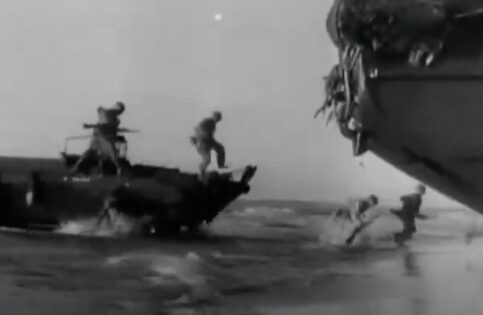
Hitting the beach at Salerno.
The Germans were waiting. They met the landing force with heavy mortar, artillery, and machine gun fire.
The T-Patchers pressed forward with grenades, small arms and bazookas.
“People talk about trial by fire,” one soldier told us in the Eagle Pass parking lot. “This was more like a trial by hellfire.”
And so it was.
Men Fought Fearlessly
On Green Beach, enemy snipers fired relentlessly from the centuries-old Tower of Paestum. A handful of Infantry and men from the 531st Shore Engineers took them out, and repelled some tanks that were lurking behind buildings. On Red Beach, soldiers crawled inland through barbed wire.
Private First Class Alfredo P. Ruiz advanced on an enemy position. He was caught in the camouflage surrounding a German tank, and was dragged for about 10 yards before he broke loose.
Ramon Gutierrez and his fellows were pinned down by four German Mark IV tanks and by fire from a machine gun nest. Two bullets pierced Gutierrez’s helmet. Those bullets missed his head, but another hit his arm. Gutiérrez charged forward, blasting away with his Browning Automatic Rifle until it was shot out of his hands. He pressed on, armed only with a hand grenade and a knife.
Gutierrez lobbed the grenade, killing three German soldiers. He stabbed a fourth to death with the knife.
Private Manuel Gonzalez was shot through the legs. As he lay wounded, a tank ran over and killed him. Another man, Pfc. Juan Pruitt, fired relentlessly from a stone wall, until he was felled by German counterfire.
Caught up in the fray, Dietrick heard an explosion to his left. He saw a man slumped over. He ran to see if the man was okay.
“He had blood running down his temple, and his eyes were open and glazed,” he said.
A German soldier jumped up from a nearby bush.
“I sprayed my rifle at him,” Dietrick said. “I got him.”
Dietrick raced forward. With his bazooka, he hit an advancing enemy Panzer. The strike disabled the engine, but left the crew alive. The machine gunner opened fire.
“It came so fast it was just a streak of fire,” Dietrick said. “Miraculously, it missed me.”
Elsewhere, Sergeant James Logan’s unit came under withering machine gun fire. In just over three hours, the men advanced 800 yards. Logan pushed forward, killing or capturing enemy forces, and taking out a sniper.
The heroic sergeant would become one of 14 T-Patchers to receive the Medal of Honor from actions in Operation Avalanche.
“Those men fought bravely and honorably,” said Dave Gutierrez, who researched the battle and wrote a book about his cousin’s E Company, Patriots from the Barrio. “They went up against a very determined enemy.”
Amid the overwhelming violence came intermittent moments of levity.
At one point, Dietrick took cover inside a shell hole. He lay on his back, staring up at the stars while holding a captured enemy P-38 pistol atop his chest. He began to think about his family at home in Texas.
“Suddenly a shadow appeared. A figure was standing over me.”
Dietrick decided he would ask the codeword known only to American troops. “If he didn’t answer with the codeword, I was going to shoot him.”
The figure advanced.
“It was a horse!” Dietrick laughed. “I didn’t shoot him.”
The battle raged for days. During that time, fortunes vacillated, and no clear victor emerged.
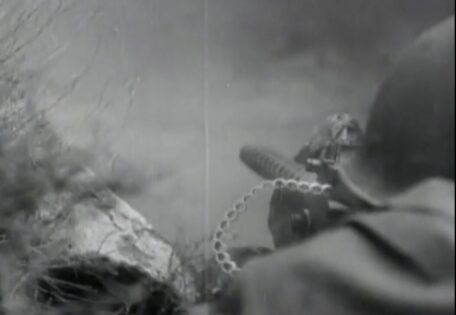
An American soldier at Salerno. U.S. Army image.
Several days into Operation Avalanche, Technical Sergeant Charles E. Kelly reconnoitered a German position, crawling for two miles and back through artillery, mortar and sniper fire. Popularized as “Commando Kelly,” the so-called “one man army” wreaked havoc on the enemy.
“He was made for it,” one of the Eagle Pass soldiers told us. “A badass for hellacious combat.”
The fight overall nearly became a catastrophe, British forces recall. According to the Imperial War Museums, the expected “soft underbelly of Europe” turned out to be a “tough old gut.”
The T-Patchers were tougher. On Sept. 16, a patrol from the 36th ID met up with men from British Field Marshal Bernard Montgomery’s Eighth Army, closing the gap in the Allied lines surrounding the beachhead.
By Oct. 1, the beachhead fully was secured. Operation Avalanche came to a close. In the short span of its existence, some 1,900 T-Patchers were either killed in action, wounded, captured, or missing.
The T-Patchers continued to fight throughout the Italian Campaign, which lasted through war’s end in 1945. In that time, they achieved much. They captured or accepted the surrender of high profile enemy personnel, including Reichsmarshal Hermann Goering; 22 leading Nazi commanders; and 19 generals. Among other things, they broke through the infamous Siegfried Line, a 390-mile stretch of bunkers and fortifications aiming to prevent Allied incursions into Nazi Germany from the west. They also hosted an early embed for war correspondent Ernie Pyle, and provided humanitarian assistance to civilians when Mt. Vesuvius erupted in March 1944.
At campaign’s end, their commander, Major General Walker, reflected on how the men conducted themselves.
“I do not recall any campaign in the whole history of the United States Army in which soldiers have had to endure greater hardships or have performed greater deeds of heroism than this campaign in Italy,” he said.
Their feats are legend, and formed the basis for a song, “The Eyes of the World Are On You 36th.” Their legacy endured in the hearts of the men who fought.
“I think about it every day,” said Dietrick, before he passed away peacefully in June 2023. “It never left me.”
The legacy endures also with those who are young to the unit, and who currently serve along the U.S. border with Mexico. So much so, that they asked Soldier of Fortune to write about them.
“Raise a glass in their honor,” one soldier said. “Please tell the American people.
“Tell them about Salerno.”
With reporting by Jose Campos.
Susan Katz Keating is the publisher and editor in chief at Soldier of Fortune.
 Soldier of Fortune Magazine The Journal of Professional Adventurers
Soldier of Fortune Magazine The Journal of Professional Adventurers


